What are Mahakal JyotirLinga history (information) (facts) | Dooshan and four brahmins story
Namaste friends, how are you doing today? Welcome to #BhagavanBhakthi website / blog.
Bhagavan Lord Sri Vishnu and Lord Shiva blessings to you and your family!
In this website / blog, you will always learn about #Hinduism #Sanskrit language.
Also subscribe to my YouTube channel from this link #BhagavanBhakthi to view videos about #Hinduism #Sanskrit language.
Just before moving towards to know about “Mahakal JyotirLinga history (information) (facts) | Dooshan and four brahmins story“, let us know few basic information about the beautiful Lord Shiva family.

Lord Shiva is the head of this family. His consort name is Goddess Sri Parvati Devi.
They have two sons namely Lord Ganesha and Lord Kartikeya.
Lord Ganesha has divine elephant face, while Lord Kartikeya has 6 heads and thus Lord Kartikeya is known as as ‘Shanmukha‘.
(Here Shanumukha = Shan + Mukha. Here Shan = 6 and Mukha = face. Shanmukha is someone who has 6 head or faces).
Lord Shiva, Goddess Sri Parvati Devi, Lord Ganesha and Lord Kartikeya all stay in a divine place called Kailasha (Kailash).
Along with these four of them, there are multiple other divine people living in Kailasha (Kailash).
Few of the names are Nandi, Bhringi, many Ganas, etc.
Lord Shiva’s mount is Nandi, Goddess Sri Parvati Devi mount is Simha (Divine Lion),
Lord Ganesha mount is Mushaka (Mushak) (Divine Mouse) and Lord Kartikeya mount is Mayura (Mayur) (Divine Peacock).
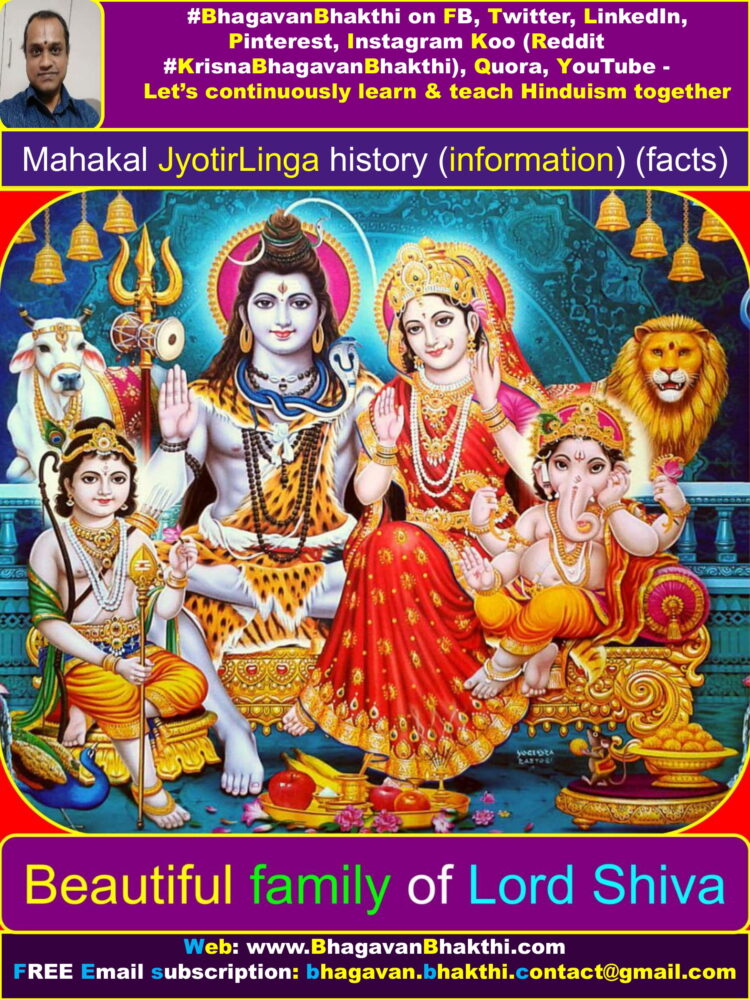
Story about Mahakal (Mahakaleshwar) JyotirLinga is as given below:
The city of Avanti (Today’s Ujjain in Madhya Pradesh) is on the banks of the river Kshipra (Shipra).
A brahmana named Vedapriya used to live in the city of Avanti (Today’s Ujjain in Madhya Pradesh).
Vedapriya used to worship Lord Shiva everyday and he had brought up his four sons to do the same.
Vedapriya’s sons were named as: Devapriya, Priyamedha, Suvrita and Suvrata.
Not very far away, on a hill named Ratnamala, there used to live an asura (demon) named Dushana (Dooshan).
Dushana (Dooshan) was evil, he could not stand the idea of the Vedas being read and the religion prescribed in them followed.
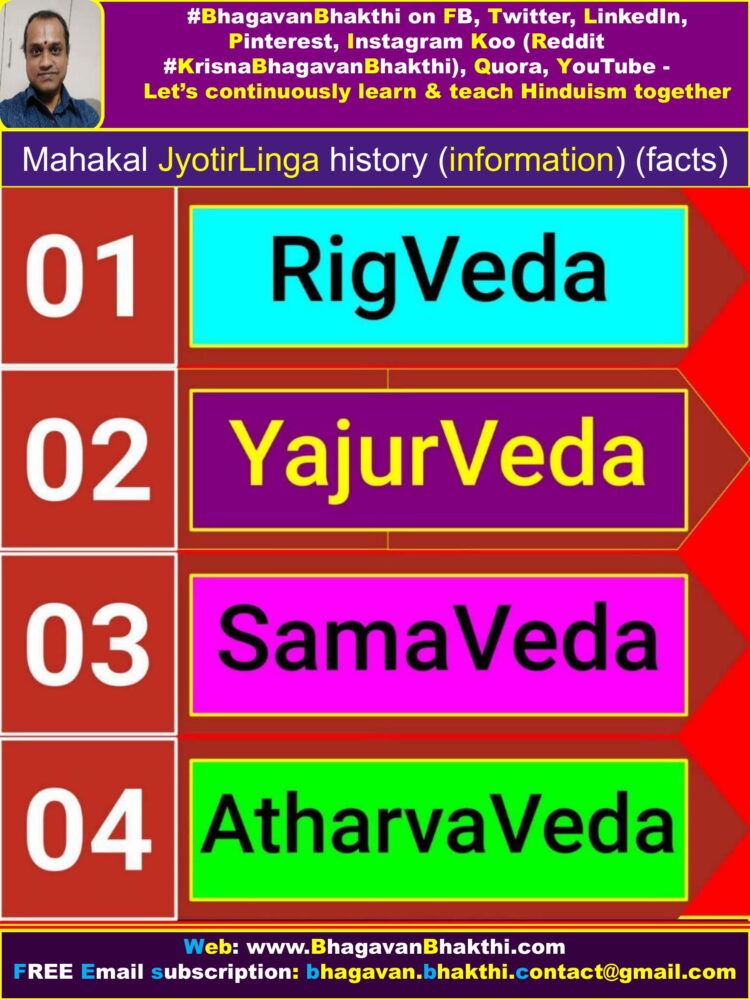
Dushana (Dooshan) went about destroying this righteous religion wherever he could.
Dushana (Dooshan) got to know that in the city of Avanti (Today’s Ujjain in Madhya Pradesh) there lived four brahmanas (brahmins) who followed the righteous religion and worshipped Lord Shiva.
These were Devapriya, Priyamedha, Suvrita and Suvrata. Their father Vedapriya had died by then.
Dushana (Dooshan) and his cohorts came and attacked the city of Avanti (Today’s Ujjain in Madhya Pradesh).
Dushana (Dooshan) and his group threatened to kill the four brahmanas, but the brothers were not at all perturbed.
All the four brothers continued to pray to Lord Shiva. They bowed in obeisance before the Lord Shiva Linga.
Suddenly a tremendous sound was heard and a pit appeared in the ground in front of the Lord Shiva Linga.
Lord Shiva himself appeared in this pit.
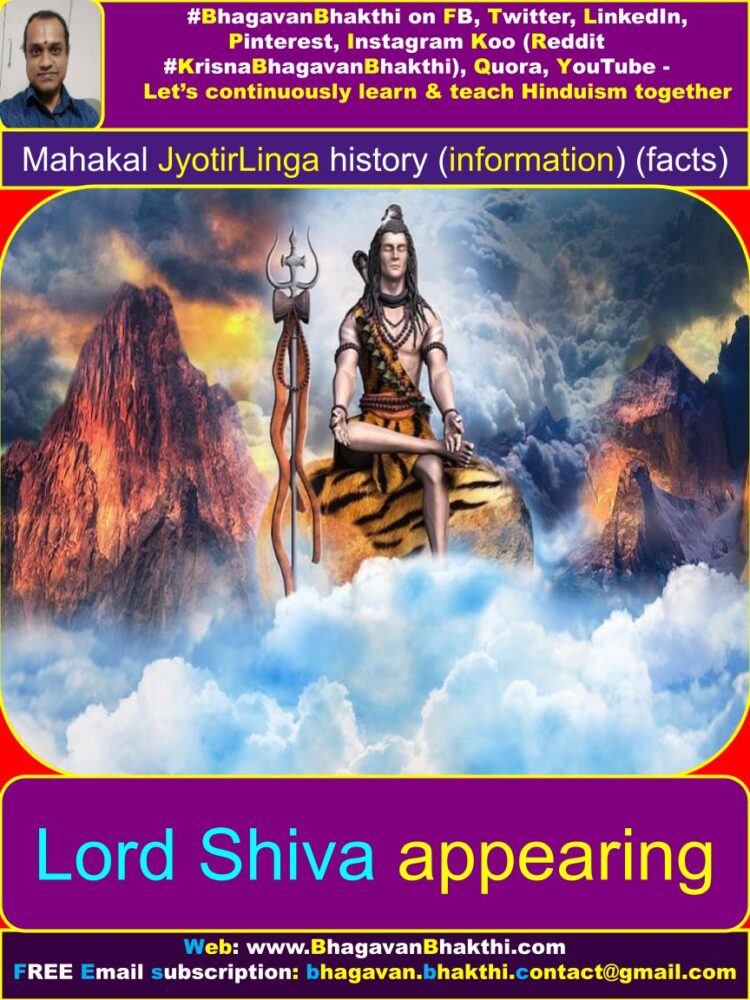
Dushana (Dooshan) was burnt into ashes from the force of Lord Shiva’s roar. And Lord Shiva put all of Dushana’s (Dooshan) soldiers to flight.
The brahmanas (brahmins) prayed that Lord Shiva should always be present at that place and for this the Karunasagara (always kind heartedly) Lord Shiva agreed.
This is the place that is known as Mahakala (Mahakal) (Mahakaleshwar) (Mahakaleshwara) (Mahakalesvara) (Mahakalesvar).
About Mahakaleshwar Ujjain temple information is as given below:
The divine and great temple of Mahakaleshwar Ujjain is three-storeyed building.
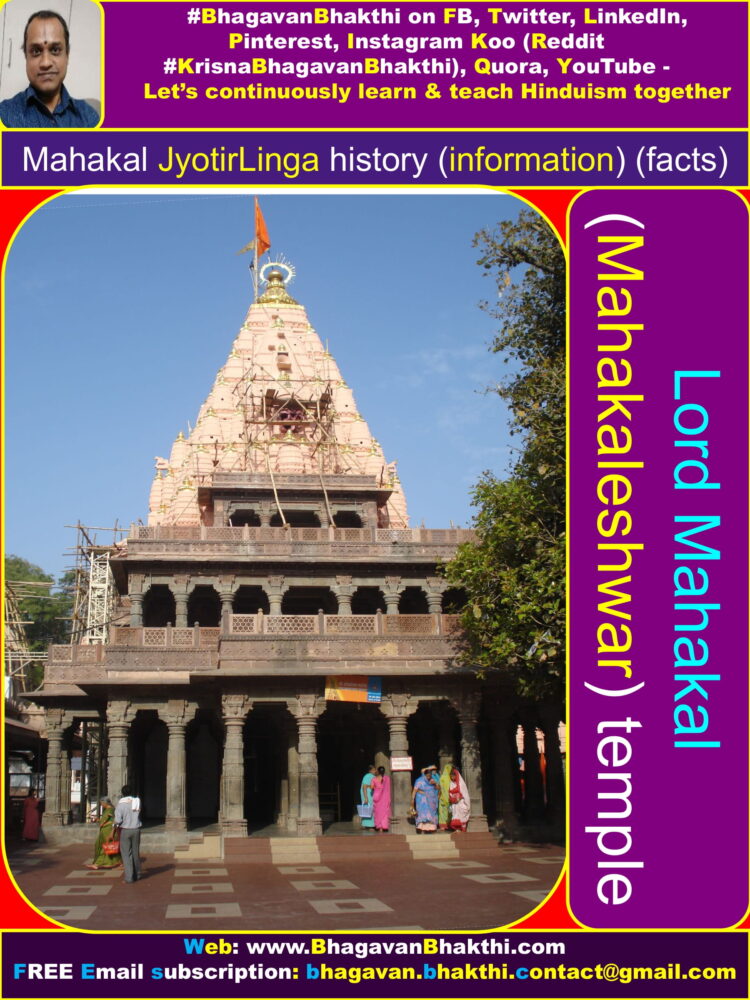
The lowest floor, middle floor and top floor are respectively installed the lingams as given below:
Lord Mahakalesvara (Lowest floor), Lord Omkaresvara (Middle floor), and Lord Nagachandresvara (Top floor).
The visitors and the pilgrims can only have the darshan of Lord Nagachandresvara on the festive season of Naga Panchami (Nag Panchmi) and not on the other common days.
A vast size Kunda (Kund) named ‘Koti Tirtha‘ (Koti Tirth) also exists in the temple-complex of Lord Mahakaleshwar.
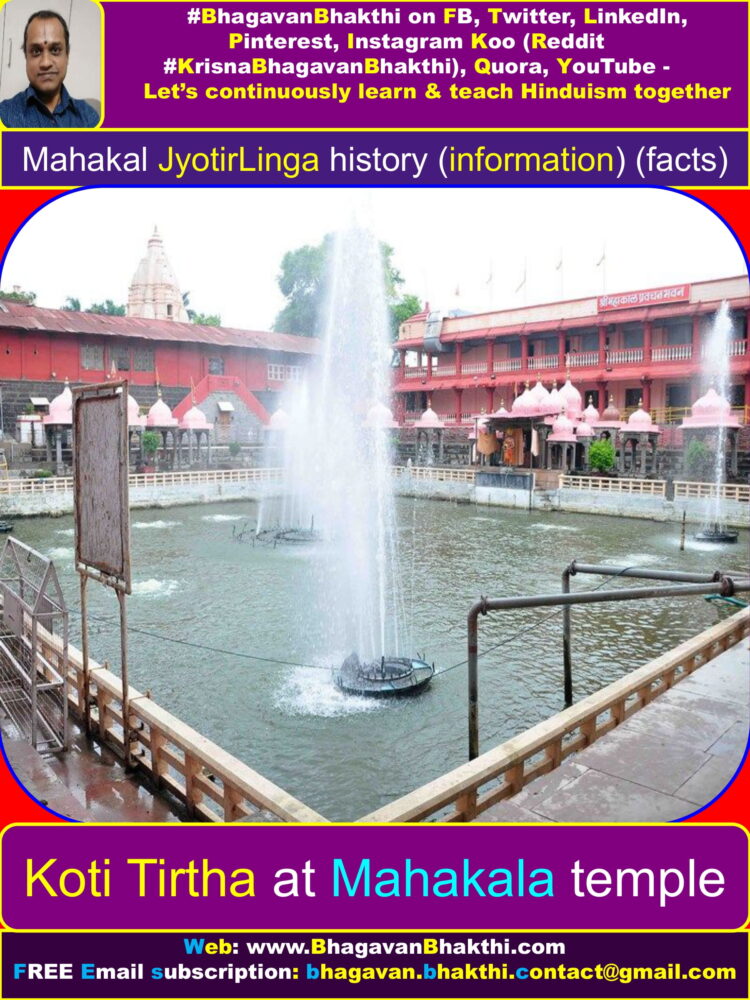
This is a Kunda (Kund) is located near the southern side of Mahakaleshwar temple.
If some one takes the bath in this Kunda (Kund), then it is similar to having bath at crores (Koti or unlimited) of Tirthas and thus the name Koti Tirtha.
This Kunda (Kund) was build by the great devotee of Lord Rama, that is, by Lord Hanuman himself.
This particular Kund (Kunda) is built in the sarvatobhadra style.
(Sarvatobhadra Style meaning: These class of the temples have four functional doors on cardinal direction.
And also they have a Pradakshinapatha with a row of 12 pillars around the garbha griha (sanctum sanctorum).
(The specialty of these class of temples is that they can be easily accessed from all sides.)
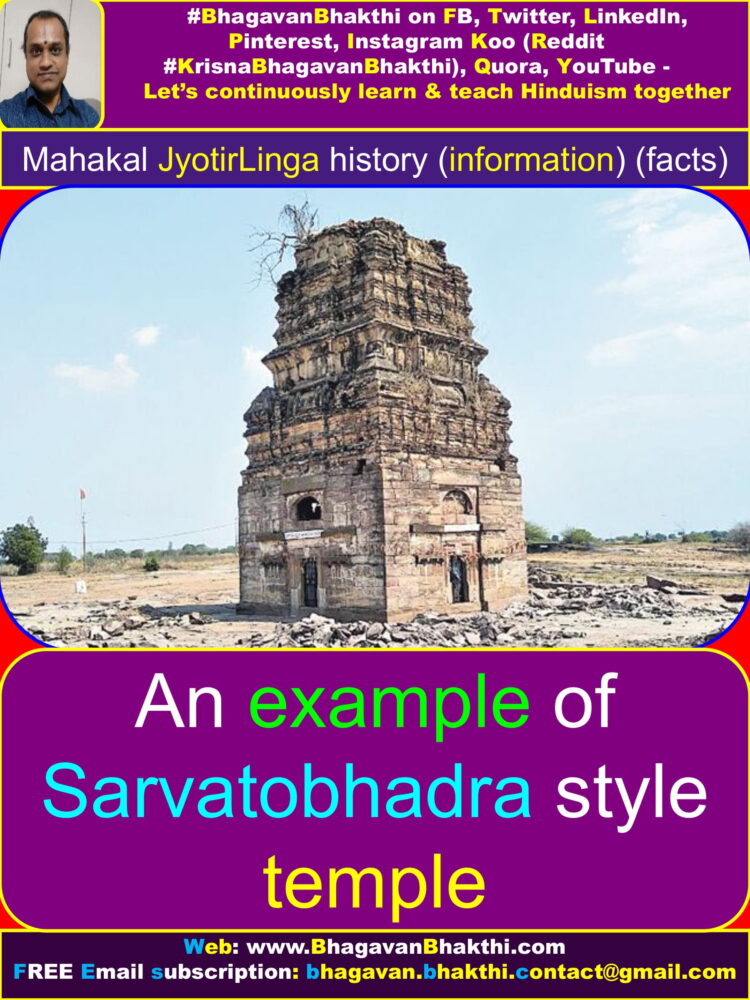
The Kunda (Kund) and its water both being regarded as very divine and heavenly.
Also, there is a path adjoining the stairs of the Kunda (Kund) which represents the carving grandeur of the temple built during the Paramara (tradition) period.
In the Purva dik (eastern side), there is a divine Kunda (Kund) which is a huge size Veranda in which there is the entrance to the path leading to the garbha griha (sanctum sanctorum).
In the Uttar dik (northern side) of the verandah, the deity of Lord Sri Rama and Goddess Sri Avantika Devi are worshipped.
In the dakshin dik (southern side) of the main shrine, there stand many small Shaiva style temples constructed in the regime of Shinde.
Among these, the popular temples are as given below:
Lord Sri Vriddha Mahakaleshvara, Lord Sri Anadi Kalpeshvara and Saptarishi are most important and are the spectacular pieces of Hindu Sanatana Dharma architectural works.
The Mahakaleshwar Linga is of very huge in size and easily visible to all the devotees.

A silver coated Naga Jaladhari and the inscribed and esoteric silver coated covering the roof of the garbha griha (sanctum santorum) always add that extra splendid to the deity of Lord Mahakaleshwar (Mahakaleshwara).
Besides the divine and great Jyotirlinga of Lord Mahakaleshwar, very charismatic and smaller sized deities of Lord Ganesha, Lord Kartikeya and Goddess Sri Paravati Devi can also be seen in the garbha griha (sanctum sanctorum).
All around the walls, classical shlokas in the praise of Lord Mahakaleshwar (Shiva) are very well exhibited in the temple.
The Nanda Deepa (Dipa) always remains lit in the temple premises.
At the exit side, there is a large hall in which a most appealing metal coated stone of Nandi can be seen.
This Nandi (The mount of Lord Shiva) is in the sitting position and Nandi is always be in the humble posture.
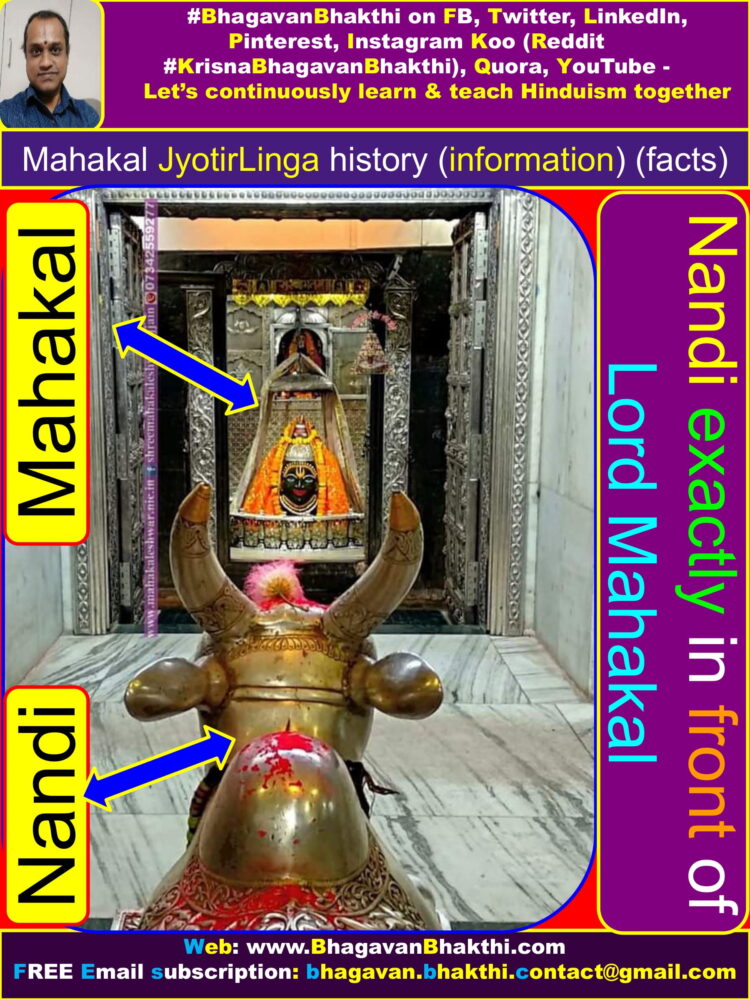
The courtyard just opposite to the Lord Omkareshwar temple adds the splendor of the temple premises.
Just adjoining to this temple of Lord Omkareshwar temple, there are two pillared projections pointing the eastern side and this adds a lot to the architectonics of the temple.
The divine and magnanimous temple of Lord Mahakaleshvar is a very well planned temple in the Bhumija, Chalukya and Maratha styles of architectonics.
The Shikhara (Shikhar) (tower) in the earlier days had been covered with golden plate.
As seen earlier, the present temple of Lord Mahakal (Mahakaleshwar) was built during the 4th – 5th decades of Eighteenth century simultaneously by the like minded and Dharma-minded nobles of Maratha community.
These divine minded Maratha community also have constructed multiple temples in the temple premises of Lord Mahakal (Mahakaleshwar).
During this period many ancient traditions, that is, like doing abhisheka, arati, sawari (procession) in the Shravan month, Harihara-milana etc., were also restored.
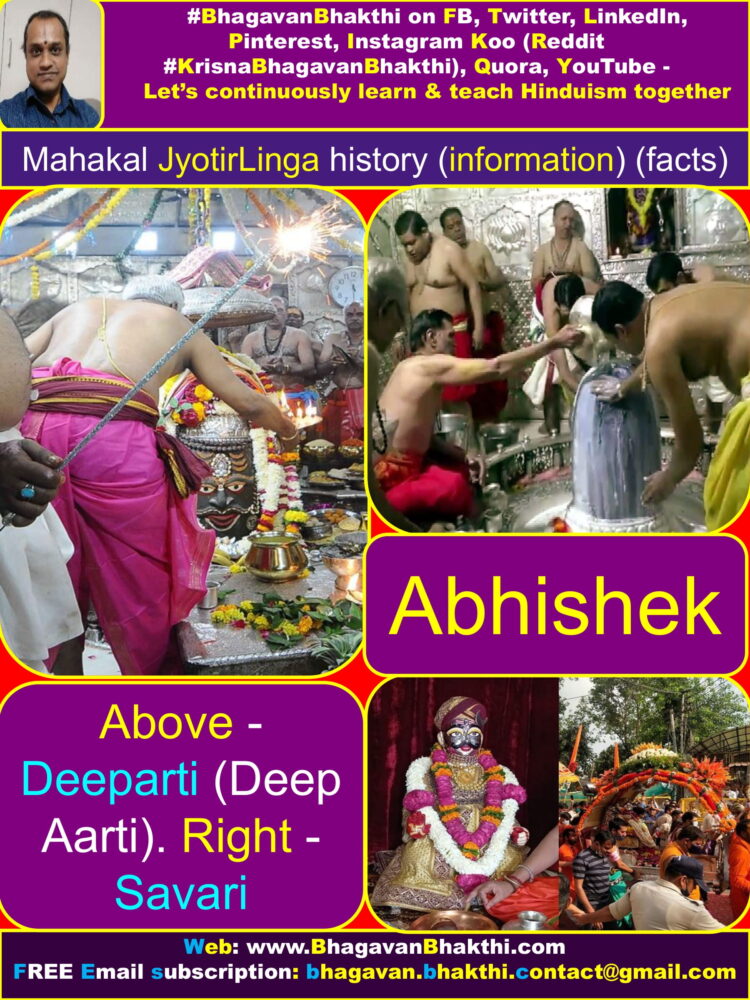
[Here Harihara-milana means = The union of Lord Sri Vishnu (Hai) and Lord Shiva (Hara).]
These are still continuing even today with joyful ceremony and devotional fervor.
About Bhasmarti to Lord Mahakal (Mahakaleshwar) is as given below:
Bhasmarti means = Bhasma (Bhasm) + Aarti = Ash + Aarti = Doing bhasma (ash) aarti to Lord Mahakal (Mahakaleshwar).
Bhasmarti is done during the early morning times especially during Mahashivaratri, Pancha-Krosi Yatra, Somavati Amavasya etc.
Proper repairs and rejuvenation of the temple premises is done at the time of the Kumbha Parva (Kumbh Parv).
In the year 1980, a unique mandapam (mantap) (A hall) was built to facilitate the devotees and the visitors.
Also in the year 1992, Madhya Pradesh Government and Ujjain Development Authority exclusively presented special repairs and made way for the stay of devotees, pilgrims and visitors.
This same procedure is also being followed at the time of the forthcoming Simhastha.
History of Lord Mahakal (Mahakaleshwar) Ujjain temple is as given below:
There is no exact date and year of the existence of the Lord Mahakal (Mahakala) (Mahakaleshwara) (Mahakaleshwar) temple.

The divine and great Hindu Sanatana Dharma puranas explains that Lord Mahakal (Mahakaleshwar) temple was first built by Lord Sri Brahma Deva himself.
For looking after the law and order situations of Mahakala temple, there is a citation to the appointment of Prince Kumarasena (Kumarsen) by king Chanda Pradyota in 6th B.C.
The seal marked coins of Avantika (Ujjain), belonging to 4th – 3rd B.C., contains the figure of Lord Shiva on them (coins).
Lord Mahakal (Mahakala) temple is also quoted in several ancient Indian poetic Hindu Sanskrit texts.
One of the most famous poets who have given information about Lord Mahakal (Mahakaleshwar) temple is Kalidasa (Kalidas).
According to these Hindu Sanskrit texts, the temple had been very splendid and humongous.
Lord Mahakal (Mahalakeshwar) temple’s foundation and platform were constructed of divine stones and also this temple was placed rested on the wooden pillars.
This temple never had the shikharas (peaks) prior to the Gupta period and roofs of the temple was mostly flat.
Kalidasa (Kalidas) in his great work of Raghuvamsham explains that this temple as ‘Niketana’ (similar to mansion).

In the early part of the Meghadutam (Purva Megha), Kalidasa (Kalidas) gives a captivating explanation of the Lord Mahakal (Mahakaleshwar) temple.
The temple of Lord Mahakal (Mahakaleshwar) was enclosed by high ramparts attached with the entry-gates.
The echo of the Jaya-dhvani (the voice the victory) of the assembly of the devotees was heard far and wide away from the temple.
Lord Mahakal (Mahakaleshwar) temple’s priests remained busy in worshipping the Deity and chanting eulogies of Lord Shiva through out the year.
The divine and great Vedic shlokas (hymns) were recited and stotras were sung 7 days of the week and 365 days of the year.
After the decline of the Gupta empire, several dynasties including the Chalukyas, Maitrakas, Kalachuris, Gujrara Pratiharas, Later Guptas, Pusyabhutis, Rastrakutas etc. dominated the political scenario in Avantika (Today’s Ujjain) one after the other.
However, all the emperors and empires bowed down before Lord Mahakal (Mahakaleshwar) and distributed endowments and alms to the needy and devotees.
During this period a number of temples of various Devatas (Demigods), Tirthas, Kundas, Vapis and gardens took shape in Avantika (Today’s Ujjain).

Several Shaiva temples including those of 84 Mahadevas existed here.
This fact should specifically be understood that when every nook and corner of Avantika (Ujjain) was dominated by religious monuments housed by the images of their respective deities,
the development and progress of Lord Mahakal temple and its religious and cultural environment was never neglected at all.
Among many of the poetic Hindu Sanskrit texts composed during this period, which sung the significance and glamour of the temple –
Harshacharit and Kadambari of Banabhatta, Naisadhacharit of Sri Harsha, and Navasahasamkacharit of Padmagupta are highly impressive.
How to reach Lord Mahakal (Mahakaleshwar) temple: The city of Ujjain is very well equipped and also very well connected with road, rail and air.
City of Ujjain belongs to the Western Railway and is connected by direct train to most major Indian cities.
The nearest airport to reach temple of Lord Mahakal (Mahakaleshwar) is Indore Airport.

The road connectivity is developed with other parts of Madhya Pradesh.
Ujjain city is connected to Indore through SH-27 and also SH-18 Dewas-Badnawar passes through it.
More information will be added to this on regular, please visit after some time to know more information.
To watch videos on #Hinduism #Sanskrit language, SUBSCRIBE to my YouTube channel from this below link:
#BhagavanBhakthi YouTube channel
To know more about “Lord Krishna unknown facts“, please click the below link:
To know more about “Lord Vishnu unknown facts“, please click the below link:
To know more about “Lord Shiva unknown facts“, please click the below link:
Dear friends, if you need any clarifications about this post, kindly let me know, I will definitely try to answer all of them.
Also your one LIKE, one COMMENT, One Share, one SUBSCRIPTION is highly important.
This will help to know the quality of this content and also it will be helpful to know if any improvements is required for the content.
If you feel this content is useful to you and has helped you to improve your knowledge, kindly share this with your well-wishers.
Because “SHARING MEANS CARING”.
For receive FREE EMAIL SUBSCRIPTION about #BhagavanBhakthi, you can send an email to [email protected] from your email ID.
NAMASTE!
Sri Gurubhyo Namaha
OM NAMO NARAYANAYA
Sri Krishnaarpanamastu